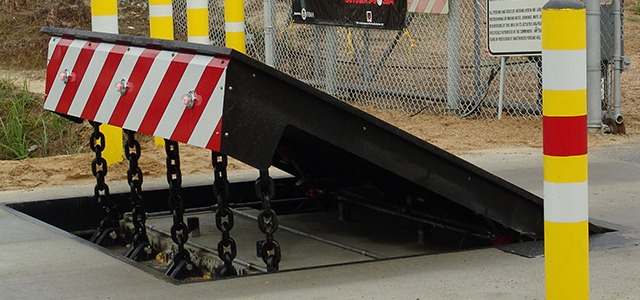Indicators on Wedge Barriers You Should Know
Wiki Article
The 4-Minute Rule for Wedge Barriers
Table of ContentsAbout Wedge BarriersAll About Wedge Barriers

The Of Wedge Barriers
g., springtime support 65 )might be repaired to completion of the spring pole 58 to make it possible for compression of the springs 60. As the springs 60 are compressed between the spring supports 62, the spring assembly 54 generates a pressure acting on the camera combined to the spring rod 58 in a direction 66. For instance, the staying force related to the cam to release the wedge plate 16 may be supplied by an electromechanical actuator 84 or various other actuator. Therefore, the springtime setting up 54 and the actuator 84(e. g., electromechanical actuator)might run together to convert the webcam and lift the wedge plate 16.
As stated above, the springtime setting up 54 exerts a constant pressure on the webcam, while the electromechanical actuator may be regulated to exert a variable pressure on the webcam, consequently enabling the lifting and reducing( i. e., releasing and withdrawing )of the wedge plate 16. In particular embodiments, the continuous force used by the springtime assembly 54 might be adjustable. g., electromechanical actuator) is handicapped. As will be valued, the springtime setting up 54 may be covered and shielded from debris or other aspects by a cover plate(e. g., cover plate 68 displayed in FIG. 4) that might be considerably flush with the raised surface 38 of the foundation 14. As stated above, in the released position, the wedge plate 16 serves to obstruct gain access to or traveling past the barrier 10. The barrier 10(e. g., the wedge plate 16 )might block pedestrians or cars from accessing a building or path. As discussed above, the barrier 10 is connected to the support 30 safeguarded within the structure 14,

front brackets 71. As an outcome, the affiliation settings up 72 may pivot and revolve to make it possible for the collapse and expansion of the linkage assemblies 72 during retraction and release of the bather 10. The linkage assemblies 72 cause motion of the wedge plate 16 to be restricted. As an example, if an automobile is taking a trip in the direction of the released wedge plate 16(e. For instance, in one condition, the safety legs 86 might be prolonged throughoutmaintenance of the obstacle 10. When the safety and security legs 86 are deployed, the security legs 86 sustain the weight of the wedge plate 16 versus the surface 12. Consequently, the training mechanism 50 may be shut down, serviced, eliminated, changed, and so forth. FIG. 5 is partial perspective sight of a personification of the surface-mounted wedge-style obstacle 10, illustrating the cam 80 and the camera surfaces 82 of the lifting system 50. Specifically, two webcam surfaces 82, which are described as reduced cam surfaces 83, are placed listed below the web cam 80. The lower cam surface areas 83 might be fixed to the surface area 12 (e. As an example, the lower cam surfaces 83 and the placing plate 85 might develop a single item that is safeguarded to the anchor 30 by bolts or various other mechanical fasteners. Additionally, 2 webcam surfaces 82, which are described as top Recommended Reading cam surfaces 87, are positioned above the webcam 80 and coupled to (e. In various other embodiments, intervening layers or plates may be placed between the surface 12 and the reduced web cam surfaces 83 and/or the wedge plate 16 and the top web cam surface areas 87 As discussed over, the webcam 80 equates along the web cam surfaces 82 when the wedge plate 16 is lifted from the retracted placement to the deployed setting. Furthermore, as discussed over, the springtime setting up 54 (see FIG. 3 )may supply a pressure acting upon the webcam 80 in the direction 102 by means of springtime pole 58, which may minimize the pressure the electromechanical actuator 84 is required to apply to the web cam 80 in order to activate and lift the wedge plate 16. 1 )to the released setting(see FIG. 4). As revealed, the cam 80 includes track wheels 104(e. g., rollers), which contact and convert along the cam surfaces 82 during operation.
Report this wiki page